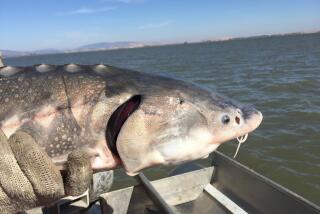Wildlife Service to Review Plover’s Protected Status
The U.S. Fish and Wildlife Service on Monday took the first step toward removing the Western snowy plover from the list of endangered species, a move that could end more than a decade of beach restrictions and other government efforts to keep the shorebird from going extinct.
The action, which begins a 12-month timetable for scientific study and review, was prompted by petitions from the city of Morro Bay and a citizens group in Lompoc, upset that sections of their beaches have been fenced off during the plover’s lengthy nesting season.
The tiny gray-brown and white plover has emerged as a bird that developers and off-road vehicle drivers love to hate. A popular bumper sticker reads “Eat Plover.”
State and federal restrictions to protect the plovers that nest on prime real estate -- sandy beaches near the ocean -- have thwarted some construction, put popular beaches off-limits to sunbathers and reduced the size of a sandy playground set aside for off-roaders near Pismo Beach.
“It would be bad enough to close beaches for a bird that is endangered or threatened; it’s a crime to do it for a bird that’s not,” said Greg Broderick, a Pacific Legal Foundation attorney who filed a lawsuit to force the delisting question. Broderick maintains that the government relied on “junk science” to list the plover as threatened under the Endangered Species Act.
A Sierra Club representative said she was glad that the U.S. Fish and Wildlife Service was reviewing what she called the “precarious” status of the plover.
“We are confident that an impartial review of the evidence will demonstrate the need to upgrade the listing for the Western snowy plover from ‘threatened’ to ‘endangered,’ ” said Tarren Collins, chairwoman of a club chapter on the Central Coast.
The federal government has spent more than a decade trying to reverse the decline of an estimated 1,600 plovers on the West Coast. It spent years fashioning an elaborate recovery plan and designated 180 miles of coastline as “critical habitat” that needed to be preserved -- until a federal judge in Eugene, Ore., ordered the agency to rework the designation because it did not consider the economic effects of such a decision.
About 145 miles of designated habitat remains, and federal and state officials -- such as Vandenberg Air Force Base and Oceano Dunes State Vehicular Recreation Area -- have set some broad areas off-limits to keep people and motorized vehicles from inadvertently crushing plover eggs and chicks in the sand.
The latest counts show that the number of plovers has begun to rebound. Last year, biologists spotted 1,371 plovers, up from 976 birds three years earlier. The government believes that the population needs to climb to more than 3,000 before the species is considered “recovered.”
Yet Morro Bay and the Lompoc-based Surf Oceano Beach Commission have challenged the recovery strategy by presenting new information that warrants reconsideration of existing protections for the coastal plover, federal officials said.
Specifically, the groups presented a genetic study by a graduate student finding that the beach-dwelling plovers showed no genetic differences from a much larger population of Western snowy plovers that winters on the shoreline but then flies to the Great Salt Lake in Utah and other salty inland lakes to breed.
Glen Tarr, a fish and wildlife biologist, said the genetic work, which was done as part of an unpublished master’s thesis, raises the possibility that the two populations are interbreeding. In the early 1990s, biologists determined that the coastal plovers were a “distinct population segment” by banding thousands of birds and observing that they didn’t crossbreed with their inland cousins.
Tarr said that additional genetic analysis could determine whether the 1,600 coastal plovers and the roughly 16,000 inland birds are interbreeding. “If they are interbreeding,” he said, “then we should treat them as one population.”
That would raise their numbers high enough to eliminate the need for further protection.
More to Read
Sign up for Essential California
The most important California stories and recommendations in your inbox every morning.
You may occasionally receive promotional content from the Los Angeles Times.








